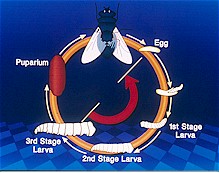Blowfly
Blowfly
Blowflies are insects belonging to the family Calliphoridae. They are commonly known for their metallic blue, green, or black coloration. Blowflies are often found around decaying organic matter, where they lay their eggs. The larvae, commonly known as maggots, play a crucial role in the decomposition process.
Taxonomy and Classification
Blowflies belong to the order Diptera, which encompasses all true flies. Within the family Calliphoridae, there are several genera, including Lucilia, Phormia, and Calliphora. These genera are distinguished by their unique morphological characteristics and ecological niches.
Life Cycle
The life cycle of a blowfly consists of four stages: egg, larva (maggot), pupa, and adult. Female blowflies lay their eggs on decaying organic matter, such as carrion or feces. The eggs hatch into larvae, which feed on the decaying material. After several molts, the larvae pupate, and eventually, adult flies emerge.
Ecological Role
Blowflies are important decomposers in many ecosystems. Their larvae help break down dead animals and other organic matter, recycling nutrients back into the environment. This process is essential for nutrient cycling and soil health.
Medical and Forensic Importance
Blowflies are of significant interest in the fields of forensic entomology and medical entomology. In forensic investigations, the presence and development stages of blowfly larvae can help estimate the time of death in cases of unattended deaths. In medical contexts, blowfly larvae have been used in maggot therapy to clean non-healing wounds by consuming dead tissue.
Species of Interest
Some notable species of blowflies include:
- Lucilia sericata - Common green bottle fly, often used in maggot therapy.
- Phormia regina - Black blowfly, commonly found in forensic cases.
- Calliphora vomitoria - Bluebottle fly, known for its distinctive blue coloration.
Control and Management
Blowflies can be pests, particularly in agricultural settings where they may infest livestock wounds. Control methods include proper sanitation, use of insecticides, and biological control agents such as parasitic wasps.
Related Pages
References
External Links
Transform your life with W8MD's budget GLP-1 injections from $125.
W8MD offers a medical weight loss program to lose weight in Philadelphia. Our physician-supervised medical weight loss provides:
- Most insurances accepted or discounted self-pay rates. We will obtain insurance prior authorizations if needed.
- Generic GLP1 weight loss injections from $125 for the starting dose.
- Also offer prescription weight loss medications including Phentermine, Qsymia, Diethylpropion, Contrave etc.
NYC weight loss doctor appointments
Start your NYC weight loss journey today at our NYC medical weight loss and Philadelphia medical weight loss clinics.
- Call 718-946-5500 to lose weight in NYC or for medical weight loss in Philadelphia 215-676-2334.
- Tags:NYC medical weight loss, Philadelphia lose weight Zepbound NYC, Budget GLP1 weight loss injections, Wegovy Philadelphia, Wegovy NYC, Philadelphia medical weight loss, Brookly weight loss and Wegovy NYC
|
WikiMD's Wellness Encyclopedia |
| Let Food Be Thy Medicine Medicine Thy Food - Hippocrates |
Medical Disclaimer: WikiMD is not a substitute for professional medical advice. The information on WikiMD is provided as an information resource only, may be incorrect, outdated or misleading, and is not to be used or relied on for any diagnostic or treatment purposes. Please consult your health care provider before making any healthcare decisions or for guidance about a specific medical condition. WikiMD expressly disclaims responsibility, and shall have no liability, for any damages, loss, injury, or liability whatsoever suffered as a result of your reliance on the information contained in this site. By visiting this site you agree to the foregoing terms and conditions, which may from time to time be changed or supplemented by WikiMD. If you do not agree to the foregoing terms and conditions, you should not enter or use this site. See full disclaimer.
Credits:Most images are courtesy of Wikimedia commons, and templates, categories Wikipedia, licensed under CC BY SA or similar.
Contributors: Prab R. Tumpati, MD

